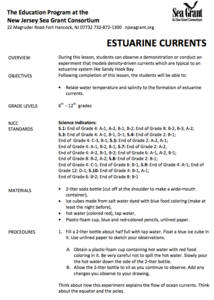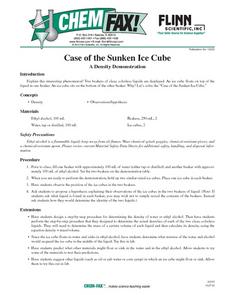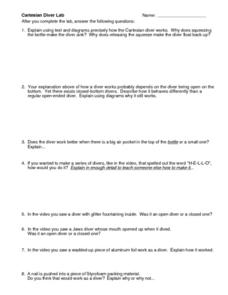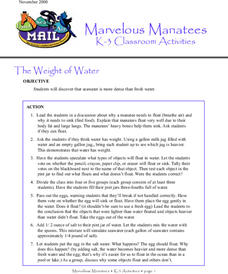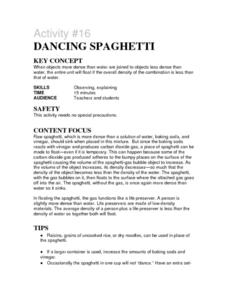Curated OER
Mountain Barriers
Students examine geographical change. In this mountain barriers lesson, students conduct an experiment to discover how mountains affect surrounding land. Students draw conclusions on how change in land affects plant and animal life.
Curated OER
Estuarine Currents
Students experiment observing a demonstration on models of density-driven currents which are typically found in an estuarine system of water flow. They compare/contrast water temperature and salinity to the formations of estuarine currents.
Curated OER
Plastic Identification Lab
In this plastics worksheet, students experiment with an unknown plastic and determine the polymer name and resin code by using a flow chart of various tests. They answer five questions after they collect their data.
Teach Engineering
Rock and Boat
Present the class with a question on whether the water level of a pond will rise they take a large rock out of a boat and drop it into the pond. Groups come down on all sides of the question and try to justify their answers. The activity...
Discovery Education
Motion in the Ocean
How do temperature changes affect ocean currents? Scholars explore convection currents by demonstrating the flow of water in a baking dish. They use ice, heat, and food coloring to see currents. Then, they draw conclusions about their...
Curated OER
Density and Buoyancy Lesson Plan
Students investigate why some objects float or sink in water. In this physics lesson, students calculate the density of clay ball using a mathematical equation. They write a complete lab report about the experiment.
Curated OER
Density Lab Activities
Students participate in several density lab activities in order to clarify the misconceptions that solids sink and liquids float. Students work with triple beam balances to find mass of objects to calculate density.
Curated OER
Transportation with Lewis and Clark
Students listen to a PowerPoint presentation and complete a Venn diagram comparing the methods of transportation in the early 1800s with today's transportation. They experiment with the buoyancy of keelboats.
Curated OER
Dunkin` for Density
In this density worksheet, students complete a science lab experiment to determine the density that an object will float or sink in water. Students fill in a chart with their data, answer 4 short answer questions and write 1 conclusion...
Curated OER
Density and Buoyancy Experimental Design
Students must plan, design, and conduct an experiment that answers the scientific question: "Come up with a question that addresses the factors (variables) of the water and its effect on whether an object floats or sinks."
Curated OER
What are Properties of Wood?
Young scholars use hands on scientific observation to determine characteristics of wood. They work directly with the materials and record their observations. Students test if wood absorbs water, if wood floats or sinks, and if all wood...
Reach Out!
Paper Clip Sailing
Students explain that some things can float on top of water because of what we call "surface tension." They see that if something happens to disturb these water molecules from tugging on each other, the skin-like surface breaks up.
Curated OER
Salinity
Learners define and discuss salinity, conduct classroom experiment to determine salinity of water sample by using hydrometer, record predictions, and demonstrate understanding of how salinity influences object's ability to float in water.
Curated OER
Science: Different Levels of Density
Students observe experiments in density and describe the results. In the experiment, milk, corn syrup, and oil are added in different orders to three glasses, while one other glass contains only water. As objects are dropped into each...
Curated OER
Cody's Science Education Zone
Students observe a scientific experiment and pose a hypothesis. In this scientific inquiry lesson, students make predictions about the combination of alcohol in water and how it will affect a floating ice cube.
Curated OER
Chemistry: The Case of the Sunken Ice Cube
Students examine a density demonstration involving ice cubes and beakers of water and alcohol. After observing how one ice cube floats in water and sinks in alcohol, they determine which mixture of the two would suspend the ice cube in...
Curated OER
Cartesian Diver Lab
In this Cartesian diver lab, students explain using text and diagrams how the Cartesian diver works. Students evaluate ways in making their lab design better. Students make predictions of how changing the variable would change the...
Curated OER
Three Methods of Heat Transfer
Students participate in a variety of experiments designed to illustrate types of heat transfer including conduction, convection and radiation. They complete worksheets as an assessment of the experiments.
Curated OER
Activity #8 Simulation of Oil Spills
Students conduct an experiment to simulate an oil spill and identify the characteristics of oil in water. They evaluate the effectiveness of various cleanup methods. They discuss the how to clean up an oil spill, and what causes oil...
Curated OER
Hot and Cold Air
In this hot and cold water worksheet, students use hot and cold water to experiment and see what happens when the two mix together. Students also answer 7 questions.
Curated OER
The Weight of Water
Students participate in an experiment about the weight of water. They work together to discover that seawater is more dense than fresh water. They also determine which objects float and sink.
Curated OER
Activity #16 Dancing Spagehetti
Students experiment with floating the spaghetti, the gas functions like a life preserver. Pupils comprehend that a person is slightly more dense than water. They comprehend that a life preservers are made of low-density materials. The...
Curated OER
Science: Exploration Tubs
First graders develop skills of scientific inquiry. They determine which objects float and which sink.
Curated OER
The Buoyancy Factor
Learners examine why some objects float in water while others sink and the ability of something to float does not depend entirely on its weight. Archimedes' principle is introduced and buoyant force is discussed. Practice calculations...



